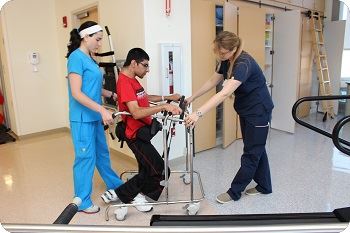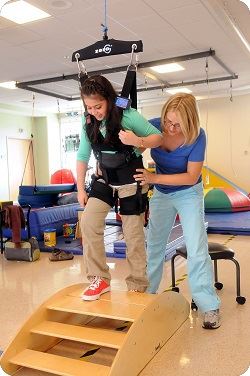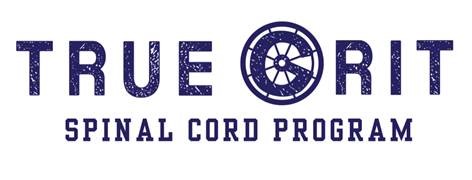Spinal Cord Rehabilitation Program
Our Specialized Care
 The Spinal Cord Rehabilitation Program at Children’s Specialized
Hospital provides intensive and comprehensive rehabilitation services
for infants, children, and adolescents with acquired, traumatic, and congenital
spinal cord dysfunction.
The Spinal Cord Rehabilitation Program at Children’s Specialized
Hospital provides intensive and comprehensive rehabilitation services
for infants, children, and adolescents with acquired, traumatic, and congenital
spinal cord dysfunction.
The program treats patients with all levels of pediatric spinal cord dysfunction, including patients who are ventilator dependent, those who need medical support, special equipment, and special feeding needs through intravenous and central lines.
Our Individualized Approach
Upon admission into our Spinal Cord Rehabilitation Program, the specialty physician and the rehabilitation team complete a comprehensive evaluation. Our team of specialists plans a treatment program and meets regularly throughout the child's stay to monitor progress and set goals. To maximize the rehabilitation potential for each patient, our hospital utilizes state-of-the-art equipment. Treatments include:
- Assistive technology
- Functional electric stimulation with cycle ergometry
- Body weight supported treadmill training
- Virtual reality
- ZeroG® gait training system
 Discharge planning begins as soon as the patient is admitted to the Spinal
Cord Rehabilitation Program. At that time, the patient and his or her
family are thoroughly educated about future needs. As discharge approaches,
the patient can make a functional trial visit to his or her home. This
ensures a smooth transition for the entire family upon discharge. Additional
services for returning to school and community activities are also available.
The program provides comprehensive follow-up, from referring the patient
to proper medical specialists to ensuring continuity of care.
Discharge planning begins as soon as the patient is admitted to the Spinal
Cord Rehabilitation Program. At that time, the patient and his or her
family are thoroughly educated about future needs. As discharge approaches,
the patient can make a functional trial visit to his or her home. This
ensures a smooth transition for the entire family upon discharge. Additional
services for returning to school and community activities are also available.
The program provides comprehensive follow-up, from referring the patient
to proper medical specialists to ensuring continuity of care.
The Spinal Cord Program treats children with conditions such as:
- Traumatic spinal cord injuries
- Cervical spinal cord injuries
- Cervical level injuries, with ventilator management and weaning (tretraplegia/quadriplegia)
- Spinal tumors
- Lower-level spinal cord injuries
- Spina bifida
- Transverse myelitis
- Nerve damage
- Spinal cord stroke
- Spinal stenosis
- Scoliosis
- Guillian-Barre Syndrome
CSH Activity Connection's True Grit Spinal Cord Program

Growing up and becoming an adult is already tough, but it's even harder when you're dealing with a spinal cord injury. That's why Activity Connection launched True Grit Spinal Cord Program to help teens and their families move forward in their personal journey of growth. True Grit Spinal Cord program provides healing, hope, and inspiration to adolescents and young adults with spinal cord injuries.
True Grit seeks to fill the gaps in rehabilitation through hosting adaptive activities (sports, leisure) with the support of peer mentors, experienced SCI therapists, and an in-person residential rehabilitation program hosted at Rutgers University with emphasis on transitioning to adulthood with a SCI. The program is for adolescents ages 16-21 with SCI post-discharge from the hospital.
Learn more about the True Grit Spinal Cord Program here.
